Envelope
An envelope is a common packaging item, usually made of thin, flat material. It is designed to contain a flat object, such as a letter or card.


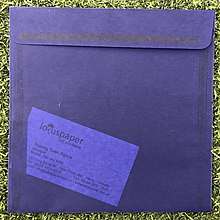
Traditional envelopes are made from sheets of paper cut to one of three shapes: a rhombus, a short-arm cross or a kite. These shapes allow for the creation of the envelope structure by folding the sheet sides around a central rectangular area. In this manner, a rectangle-faced enclosure is formed with an arrangement of four flaps on the reverse side.
Overview
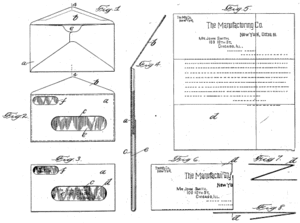
When the folding sequence is such that the last flap to be closed is on a short side it is referred to in commercial envelope manufacture as a pocket - a format frequently employed in the packaging of small quantities of seeds. Although in principle the flaps can be held in place by securing the topmost flap at a single point (for example with a wax seal), generally they are pasted or gummed together at the overlaps. They are most commonly used for enclosing and sending mail (letters) through a prepaid-postage postal system.
Window envelopes have a hole cut in the front side that allows the paper within to be seen.[1] They are generally arranged so that the receiving address printed on the letter is visible, saving the sender from having to duplicate the address on the envelope itself. The window is normally covered with a transparent or translucent film to protect the letter inside, as was first designed by Americus F. Callahan in 1901 and patented the following year.[2] In some cases, shortages of materials or the need to economize resulted in envelopes that had no film covering the window. One innovative process, invented in Europe about 1905, involved using hot oil to saturate the area of the envelope where the address would appear. The treated area became sufficiently translucent for the address to be readable. As of 2009 there is no international standard for window envelopes, but some countries, including Germany and the United Kingdom, have national standards.[3]
An aerogram is related to a lettersheet, both being designed to have writing on the inside to minimize the weight. Any handmade envelope is effectively a lettersheet because prior to the folding stage it offers the opportunity for writing a message on that area of the sheet that after folding becomes the inside of the face of the envelope.

The "envelope" used to launch the Penny Post component of the British postal reforms of 1840 by Sir Rowland Hill and the invention of the postage stamp, was a lozenge-shaped lettersheet known as a Mulready.[4] If desired, a separate letter could be enclosed with postage remaining at one penny provided the combined weight did not exceed half an ounce (14 grams). This was a legacy of the previous system of calculating postage, which partly depended on the number of sheets of paper used.
During the U.S. Civil War those in the Confederate States Army occasionally used envelopes made from wallpaper, due to financial hardship.
A "return envelope" is a pre-addressed, smaller envelope included as the contents of a larger envelope and can be used for courtesy reply mail, metered reply mail, or freepost (business reply mail). Some envelopes are designed to be reused as the return envelope, saving the expense of including a return envelope in the contents of the original envelope. The direct mail industry makes extensive use of return envelopes as a response mechanism.
Up until 1840, all envelopes were handmade, each being individually cut to the appropriate shape out of an individual rectangular sheet. In that year George Wilson in the United Kingdom patented the method of tessellating (tiling) a number of envelope patterns across and down a large sheet, thereby reducing the overall amount of waste produced per envelope when they were cut out. In 1845 Edwin Hill and Warren de la Rue obtained a patent for a steam-driven machine that not only cut out the envelope shapes but creased and folded them as well. (Mechanised gumming had yet to be devised.) The convenience of the sheets ready cut to shape popularized the use of machine-made envelopes, and the economic significance of the factories that had produced handmade envelopes gradually diminished.
As envelopes are made of paper, they are intrinsically amenable to embellishment with additional graphics and text over and above the necessary postal markings. This is a feature that the direct mail industry has long taken advantage of—and more recently the Mail Art movement. Custom printed envelopes has also become an increasingly popular marketing method for small business.
Most of the over 400 billion envelopes of all sizes made worldwide are machine-made.
Sizes
International standard sizes
International standard ISO 269 (since withdrawn) defined several standard envelope sizes, which are designed for use with ISO 216 standard paper sizes:
| Format | Dimensions (mm) | Dimensions (in) | AR | Suitable content format |
|---|---|---|---|---|
| DL | 110 × 220 | 4 1⁄3 × 8 2⁄3 | 2∶1 | 1⁄3 A4 |
| C7 | 81 × 114 | 3 5⁄24 × 4 1⁄2 | √2∶1 | A7 (or 1⁄2 A6) |
| C7/C6 | 81 × 162 | 3 5⁄24 × 6 3⁄8 | 2∶1 | 1⁄3 A5 |
| C6 | 114 × 162 | 4 1⁄2 × 6 3⁄8 | √2∶1 | A6 (or 1⁄2 A5 or 1⁄4 A4) |
| C6/C5 | 114 × 229 | 4 1⁄2 × 9 | 2∶1 | 1⁄3 A4 |
| C5 | 162 × 229 | 6 3⁄8 × 9 | √2∶1 | A5 (or 1⁄2 A4) |
| C4 | 229 × 324 | 9 × 12 3⁄4 | √2∶1 | A4 |
| C3 | 324 × 458 | 12 3⁄4 × 18 1⁄24 | √2∶1 | A3 |
| B6 | 125 × 176 | 4 11⁄12 × 6 11⁄12 | √2∶1 | C6 |
| B5 | 176 × 250 | 6 11⁄12 × 9 5⁄6 | √2∶1 | C5 |
| B4 | 250 × 353 | 9 5⁄6 × 13 11⁄12 | √2∶1 | C4 |
| E4 | 280 × 400 | 11 1⁄24 × 15 3⁄4 | 10∶7 | B4 |
The German standard DIN 678 defines a similar list of envelope formats.
North American sizes
There are dozens of sizes of envelopes available in the United States.
The designations such as "A2" do not correspond to ISO paper sizes. Sometimes, North American paper jobbers and printers will insert a hyphen to distinguish from ISO sizes, thus: A-2.
| Format | Dimensions (in) | Dimensions (mm) | AR | Suitable content format |
|---|---|---|---|---|
| A2 (Lady Grey) | 4 3⁄8 × 5 3⁄4 | 111 × 146 | 1.314 | Letter paper folded twice (4 1⁄4 × 5 1⁄2) |
| A6 (Thompson Standard) | 4 3⁄4 × 6 1⁄2 | 121 × 165 | 1.368 | A2 |
| A7 (Besselheim) | 5 1⁄4 × 7 1⁄4 | 133 × 184 | 1.381 | A6 |
| A8 (Carrs) | 5 1⁄2 × 8 1⁄8 | 140 × 206 | 1.477 | A7 |
| A9 (Diplomat) | 5 3⁄4 × 8 3⁄4 | 146 × 222 | 1.522 | Letter paper folded once (5 1⁄2 × 8 1⁄2), A8 |
| A10 (Willow) | 6 × 9 1⁄2 | 152 × 241 | 1.583 | |
| C5 | 6 1⁄2 × 9 1⁄2 | 165 × 241 | 1.462 | |
| No. 6 3⁄4 (Personal) | 3 5⁄8 × 6 1⁄2 | 92.1 × 165 | 1.793 | |
| No. 7 3⁄4 (Monarch) | 3 7⁄8 × 7 1⁄2 | 98.4 × 191 | 1.935 | |
| No. 9 (A long) | 3 7⁄8 × 8 7⁄8 | 98.4 × 225 | 2.29 | |
| No. 10 (Business, Commercial) | 4 1⁄8 × 9 1⁄2 | 105 × 241 | 2.303 | No. 9 |
| No. 11 | 4 1⁄2 × 10 3⁄8 | 114 × 264 | 2.306 | No. 10 |
| No. 12 | 4 3⁄4 × 11 | 121 × 279 | 2.316 | No. 11 |
| No. 14 | 5 × 11 1⁄2 | 127 × 292 | 2.3 | No. 12 |
The No. 10 envelope is the standard business envelope size in the United States.[5] PWG 5101.1[6] also lists the following even inch sizes for envelopes: 6 × 9, 7 × 9, 9 × 11, 9 × 12, 10 × 13, 10 × 14 and 10 × 15.
Envelopes accepted by the U.S. Postal Service for mailing at the price of a letter must be:
- Rectangular
- At least 3 1⁄2 inches high × 5 inches long × 0.007 inch thick.
- No more than 6 1⁄8 inches high × 11 1⁄2 inches long × 1⁄4 inch thick.[7]
- Letters that have a length-to-height aspect ratio of less than 1.3 or more than 2.5 are classified as "non-machinable" by the USPS and may cost more to mail.[8]
Chinese sizes
| Format | Dimensions (mm) | Dimensions (in) | AR | Suitable content format |
|---|---|---|---|---|
| PRC1, Chinese #1 Envelope | 102 × 165 | 4 × 6 1⁄2 | ϕ∶1 | |
| PRC2, Chinese #2 Envelope | 102 × 176 | 4 × 6 11⁄12 | 1.725 | |
| PRC3, Chinese #3 Envelope = ISO B6 | 125 × 176 | 4 11⁄12 × 6 11⁄12 | 1.408 | C6 |
| PRC4, Chinese #4 Envelope | 110 × 208 | 4 1⁄3 × 8 5⁄24 | 1.891 | |
| PRC6, Chinese #6 Envelope | 120 × 320 | 4 17⁄24 × 12 7⁄12 | 2.667 | A4 folded once (105 mm × 297 mm) |
| PRC7, Chinese #7 Envelope (rounded ISO C5) | 160 × 230 | 6 7⁄24 × 9 1⁄24 | 1.438 | A5 |
| PRC8, Chinese #8 Envelope | 120 × 309 | 4 17⁄24 × 12 1⁄6 | 2.575 | A4 folded once (105 mm × 297 mm) |
| PRC10, Chinese #10 Envelope = ISO C3 | 324 × 458 | 12 3⁄4 × 18 1⁄24 | √2∶1 | A3 |
Japanese sizes
Japanese traditional rectangular (kakukei) and long (chōkei) envelopes open on the short side, while Western-style (youkei) envelopes open on the long side.
| Format | Dimensions (mm) | Dimensions (in) | AR | Suitable content format |
|---|---|---|---|---|
| Kaku A3 | 320 × 440 | 12 7⁄12 × 17 1⁄3 | 4∶3 | A3 |
| Kaku 0 | 287 × 382 | 11 7⁄24 × 15 1⁄24 | 1.331 | B4 |
| Kaku 1 | 270 × 382 | 10 5⁄8 × 15 1⁄24 | 1.415 | B4 |
| Kaku 2 | 240 × 332 | 9 11⁄24 × 13 1⁄12 | 1.383 | A4 |
| Kaku 3 | 216 × 277 | 8 1⁄2 × 10 11⁄12 | 1.282 | B5 |
| Kaku 4 | 197 × 267 | 7 3⁄4 × 10 1⁄2 | 1.355 | B5 |
| Kaku 5 | 190 × 240 | 7 1⁄2 × 9 11⁄24 | 1.263 | A5 |
| Kaku 6 = ISO C5 | 162 × 229 | 6 3⁄8 × 9 | √2∶1 | A5 |
| Kaku 7 | 142 × 205 | 5 7⁄12 × 8 1⁄12 | 13∶9 | B6 |
| Kaku 8 | 119 × 197 | 4 2⁄3 × 7 3⁄4 | 1.655 | salaries, wages |
| Chou 1 | 142 × 332 | 5 7⁄12 × 13 1⁄12 | 2.338 | A4 folded in half lengthwise |
| Chou 2 | 119 × 277 | 4 2⁄3 × 10 11⁄12 | 2.328 | B5 folded in half lengthwise |
| 111.1 × 146 | 4 3⁄8 × 5 3⁄4 | 1.314 | ||
| Chou 3 | 120 × 235 | 4 17⁄24 × 9 1⁄4 | 1.958 | A4 folded in thirds |
| Chou 30 | 92 × 235 | 3 5⁄8 × 9 1⁄4 | 2.554 | A4 folded in fourths |
| Chou 4 | 90 × 205 | 3 13⁄24 × 8 1⁄12 | 2.278 | JIS B5 folded in fourths |
| Chou 40 | 90 × 225 | 3 13⁄24 × 8 7⁄8 | 2.5 | A4 folded in fourths |
| You 0 | 136 × 197 | 5 3⁄8 × 7 3⁄4 | 1.449 | kyabine (cabinet) size photos (120 mm × 165 mm) |
| You 1 | 120 × 176 | 4 17⁄24 × 6 11⁄12 | 22∶15 | C6, You 2 |
| 118 × 173 | 4 5⁄8 × 6 19⁄24 | 1.466 | ||
| You 2 = ISO C6 | 114 × 162 | 4 1⁄2 × 6 3⁄8 | 1.421 | A6 (105 mm × 148 mm), Hagaki |
| You 3 | 98 × 148 | 3 7⁄8 × 5 5⁄6 | 1.51 | JIS B7 (91 mm × 128 mm) |
| You 4 (Chou 31) | 105 × 235 | 4 1⁄8 × 9 1⁄4 | 2.238 | A4 folded in thirds (99 mm × 210 mm), You 5 |
| You 5 | 95 × 217 | 3 3⁄4 × 8 13⁄24 | 2.284 | A4 folded in fourths (74 mm × 210 mm) |
| You 6 | 98 × 190 | 3 7⁄8 × 7 1⁄2 | 21⅓∶11 | |
| You 7 | 92 × 165 | 3 5⁄8 × 6 1⁄2 | 1.793 | JIS B7 |
Manufacture
History of envelopes
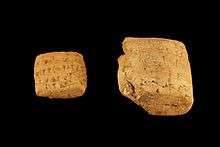
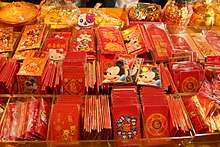
The first known envelope was nothing like the paper envelope of today. It can be dated back to around 3500 to 3200 BC in the ancient Middle East. Hollow, clay spheres were molded around financial tokens and used in private transactions. The two people who discovered these first envelopes were Jacques de Morgan, in 1901, and Roland de Mecquenem, in 1907.
Paper envelopes were developed in China, where paper was invented by 2nd century BC.[9] Paper envelopes, known as chih poh, were used to store gifts of money. In the Southern Song dynasty, the Chinese imperial court used paper envelopes to distribute monetary gifts to government officials.[10]
Prior to 1845, hand-made envelopes were all that were available for use, both commercial and domestic. In 1845, Edwin Hill and Warren De La Rue were granted a British patent for the first envelope-making machine.[11]
The "envelopes" produced by the Hill/De La Rue machine were not like those used today. They were flat diamond, lozenge (or rhombus)-shaped sheets or "blanks" that had been precut to shape before being fed to the machine for creasing and made ready for folding to form a rectangular enclosure. The edges of the overlapping flaps treated with a paste or adhesive and the method of securing the envelope or wrapper was a user choice. The symmetrical flap arrangement meant that it could be held together with a single wax seal at the apex of the topmost flap. (That the flaps of an envelope can be held together by applying a seal at a single point is a classic design feature of an envelope.)
Nearly 50 years passed before a commercially successful machine for producing pre-gummed envelopes, like those in use today, appeared.
The origin of the use of the diamond shape for envelopes is debated. However, as an alternative to simply wrapping a sheet of paper around a folded letter or an invitation and sealing the edges, it is a tidy and ostensibly paper-efficient way of producing a rectangular-faced envelope. Where the claim to be paper-efficient fails is a consequence of paper manufacturers normally making paper available in rectangular sheets, because the largest size of envelope that can be realised by cutting out a diamond or any other shape which yields an envelope with symmetrical flaps is smaller than the largest that can be made from that sheet simply by folding.
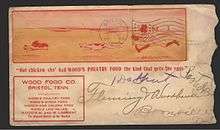
The folded diamond-shaped sheet (or "blank") was in use at the beginning of the 19th century as a novelty wrapper for invitations and letters among the proportion of the population that had the time to sit and cut them out and were affluent enough not to bother about the waste offcuts. Their use first became widespread in the UK when the British government took monopoly control of postal services and tasked Rowland Hill with its introduction. The new service was launched in May 1840 with a postage-paid machine-printed illustrated (or pictorial) version of the wrapper and the much-celebrated first adhesive postage stamp, the Penny Black, for the production of which the Jacob Perkins printing process was used to deter counterfeiting and forgery. The wrappers were printed and sold as a sheet of 12, with cutting the purchaser's task. Known as Mulready stationery, because the illustration was created by the respected artist William Mulready, the envelopes were withdrawn when the illustration was ridiculed and lampooned. Nevertheless, the public apparently saw the convenience of the wrappers being available ready-shaped, and it must have been obvious that with the stamp available totally plain versions of the wrapper could be produced and postage prepaid by purchasing a stamp and affixing it to the wrapper once folded and secured. In this way although the postage-prepaid printed pictorial version died ignominiously, the diamond-shaped wrapper acquired de facto official status and became readily available to the public notwithstanding the time taken to cut them out and the waste generated. With the issuing of the stamps and the operation and control of the service (which is a communications medium) in government hands the British model spread around the world and the diamond-shaped wrapper went with it.
Hill also installed his brother Edwin as The Controller of Stamps, and it was he with his partner Warren De La Rue who patented the machine for mass-producing the diamond-shaped sheets for conversion to envelopes in 1845. Today, envelope-making machine manufacture is a long- and well-established international industry, and blanks are produced with a short-arm-cross shape and a kite shape as well as diamond shape. (The short-arm-cross style is mostly encountered in "pocket" envelopes i.e. envelopes with the closing flap on a short side. The more common style, with the closing flap on a long side, are sometimes referred to as "standard" or "wallet" style for purposes of differentiation.)

The most famous paper-making machine was the Fourdrinier machine. The process involves taking processed pulp stock and converting it to a continuous web which is gathered as a reel. Subsequently, the reel is guillotined edge to edge to create a large number of properly rectangular sheets because ever since the invention of Gutenberg's press paper has been closely associated with printing.
To this day, all other mechanical printing and duplicating equipments devised in the meantime, including the typewriter (which was used up to the 1990s for addressing envelopes), have been primarily designed to process rectangular sheets. Hence the large sheets are in turn are guillotined down to the sizes of rectangular sheet commonly used in the commercial printing industry, and nowadays to the sizes commonly used as feed-stock in office-grade computer printers, copiers and duplicators (mainly ISO, A4 and US Letter).
Using any mechanical printing equipment to print on envelopes, which although rectangular, are in fact folded sheets with differing thicknesses across their surfaces, calls for skill and attention on the part of the operator. In commercial printing the task of printing on machine-made envelopes is referred to as "overprinting" and is usually confined to the front of the envelope. If printing is required on all four flaps as well as the front, the process is referred to as "printing on the flat". Eye-catching illustrated envelopes or pictorial envelopes, the origins of which as an artistic genre can be attributed to the Mulready stationery – and which was printed in this way - are used extensively for direct mail. In this respect, direct mail envelopes have a shared history with propaganda envelopes (or "covers") as they are called by philatelists.
Present and future state of envelopes
At the end of the 20th century, in 1998, the digital printing revolution delivered another benefit for small businesses when the U.S. Postal Service became the first postal authority to approve the introduction of a system of applying to an envelope in the printer bin of a PC sheet printer a digital frank or stamp delivered via the Internet. With this innovative alternative to an adhesive-backed postage stamp as the basis for an Electronic Stamp Distribution (ESD) service, a business envelope could be produced in-house, addressed and customized with advertising information on the face, and ready to be mailed.
The fortunes of the commercial envelope manufacturing industry and the postal service go hand in hand, and both link to the printing industry and the mechanized envelope processing industry producing equipment such as franking and addressing machines. They are all four symbiotic: technological developments affecting one obviously ricochet through the others: addressing machines print addresses, postage stamps are a print product, franking machines imprint a frank on an envelope. If fewer envelopes are required; fewer stamps are required; fewer franking machines are required and fewer addressing machines are required. For example, the advent and adoption of information-based indicia (IBI) (commonly referred to as digitally-encoded electronic stamps or digital indicia) by the US Postal Service in 1998 caused widespread consternation in the franking machine industry, as their equipments were effectively rendered obsolescent and resulted in a flurry of lawsuits involving Pitney Bowes among others. The advent of e-mail in the late 1990s appeared to offer a substantial threat to the postal service. By 2008 letter-post service operators were reporting significantly smaller volumes of letter-post, specifically stamped envelopes, which they attributed mainly to replacement by e-mail. Although a corresponding reduction in the volume of envelopes required would have been expected, no such decrease was reported as widely as the reduction in letter-post volumes.
Although, with regards to e-mail developments, there is a substantial threat of "technology replacing tradition". This is offset by the equal reasoning that the Universal Postal Union is an international specialised agency of the United Nations, and a source of revenue for the government. Consequently, any deterioration of domestic and international postal services attended by loss of revenue is a matter of governmental concern.
Types of envelopes
Windowed envelopes
A windowed envelope is an envelope with a plastic or glassine window in it. The plastic in these envelopes creates problems in paper recycling.
Security envelopes
Security envelopes have special tamper-resistant and tamper-evident features. They are used for high value products and documents as well as for evidence for legal proceedings.
Some security envelopes have a patterned tint printed on the inside, which makes it difficult to read the contents. Various patterns exist.[12]
Mailers
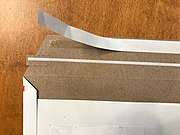
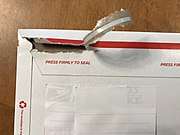
Some envelopes are available for full-size documents or for other items. Some carriers have large mailing envelopes for their express services. Other similar envelopes are available at stationery supply locations.
These mailers usually have an opening on an end with a flap that can be attached by gummed adhesive, integral pressure-sensitive adhesive, adhesive tape, or security tape. Construction is usually:
Padded mailers
Shipping envelopes can have padding to provide stiffness and some degree of cushioning. The padding can be ground newsprint, plastic foam sheets, or bubble packing.
Inter-office envelopes
Various U.S. Federal Government offices use Standard Form (SF) 65 Government Messenger Envelopes for inter-office mail delivery. These envelopes are typically light brown in color and un-sealed with string-tied closure method and an array of holes throughout both sides such that it is somewhat visible what the envelope contains. Other colloquial names for this envelope include "Holey Joe" and "Shotgun" envelope due to the holey nature of the envelope. Address method is unique in that these envelopes are re-usable and the previous address is crossed out thoroughly and the new addressee (name, building, room, and mailstop) is written in the next available box. Although still in use, SF-65 is no longer listed on the United States Office of Personnel Management website list of standard forms. [13]
See also
- Back-of-the-envelope calculation
- ✉ Envelope character in the Dingbats section of Unicode
- Green envelope, a Malay custom
- Red envelope, a Chinese custom
- Return address
- Secrecy of correspondence
References
- "History of Envelopes". BE. Retrieved 27 December 2014.
Window envelopes have a small plastic pane that fits an address printed onto the letter inside. Windowed envelopes soon became the standard for business envelopes, as they reduce the time and cost required to send mail while still ensuring it gets delivered to its intended destination.
- "US 701839 A". Retrieved 27 December 2014.
- "A software company's information on US and [[International Organization for Standardization|ISO]] international standard envelope styles and sizes". Archived from the original on 2013-05-31. Retrieved 2009-11-20.
- "Mulready stationery: Lettersheets and envelopes". The Queen's Own: Stamps That Changed the World. National Postal Museum. Retrieved 2006-09-25.
- "Envelope Size Chart - Help understanding envelope sizes". PaperPapers.com. 2018. Retrieved 2018-02-13.
- [http://ftp.pwg.org/pub/pwg/candidates/cs-pwgmsn20-20130328-5101.1.pdf PWG 5101.1
- "Sizes for Letters". USPS. 2016. Retrieved 2016-12-24.
- "Physical Standards for Commercial Letters and Postcards" (PDF). USPS. 2018. Retrieved 2018-02-13.
- Tsien, Tsuen-Hsuin (1985). "Paper and Printing". Joseph Needham, Science and Civilisation in China, Chemistry and Chemical Technology. 5 part 1. Cambridge University Press: 38. Cite journal requires
|journal=(help) - Joseph Needham (1985). Science and Civilisation in China: Paper and Printing. Cambridge University Press. p. 122. ISBN 978-0-521-08690-5.
In the Southern Sung dynasty, gift money for bestowing upon officials by the imperial court was wrapped in paper envelopes (chih pao)
- "The Heroic Age". Making the Modern World. Retrieved 2012-11-06.
- See Security Patterns by Joseph King for a selection of security patterns from around the world
- See NIH.GOV Inter-Office Communications Mail Guide for an example of usage instructions
External links
| Look up envelope in Wiktionary, the free dictionary. |
| Wikimedia Commons has media related to Envelopes. |
- Maynard H. Benjamin (2002). "History of Envelopes" (PDF). Envelope Manufacturers Association. Available via the Smithsonian National Postal Museum
- "ISO 216:2007 - Writing paper and certain classes of printed matter". International Organization for Standardization.
- Markus Kuhn. "International standard paper sizes". University of Cambridge. the ISO 216 paper size system and the ideas behind its design.
- Bodleian Library (2001). "De la Rue's Stationery Stand and Envelope Machine (1851)". John Johnson Collection Exhibition. University of Oxford.
- Gerard Hughes. "Envelope and Letterfolding". Methods from the Envelope and Letter Folding Association
- papersizes.guide. "International Envelope Paper Sizes". papersizes.guide
